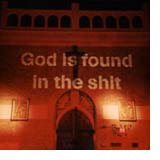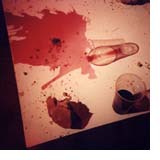
February 2002
How far is too far?
Previous Small Fires
 ENTERING VAUX, in St Peter's Church, Vauxhall, South London, always feels like finding a private nightclub. I follow the taped-up signs and slide in off the street through a door open just a crack. Inside, the usual happy throng and red lights... until I turn round. Above the door by which I entered, in foot-high letters: God is found in the shit. Welcome to Vaux's "season of dirt".
ENTERING VAUX, in St Peter's Church, Vauxhall, South London, always feels like finding a private nightclub. I follow the taped-up signs and slide in off the street through a door open just a crack. Inside, the usual happy throng and red lights... until I turn round. Above the door by which I entered, in foot-high letters: God is found in the shit. Welcome to Vaux's "season of dirt".Kester opens with an explanation. Over the next few services Vaux want to examine our ideas of the "purity" of God. We have made God too "pure". We live impure lives in an impure city. Our concern for God's purity has placed him out of our reach, detached him from our world. We are tempted to believe that the only way to seek God is to leave behind our present compromised circumstances. For most of us this is not an option, and it offers no hope of redemption for the places we live in.
But God has dared to enter into our impurity, has faced contamination for the sake of being with us where we are. Christ persistently crossed the bounds between "clean" and "unclean" in order to be with those in need. The religious, then as now, were appalled. Kester retold the story of philosopher Carl Jung's famous dream – of God destroying a church by dropping a giant turd from heaven. When the Church is too zealous for God's purity it denies his active love.
TO SAY THAT GOD embraced our dirt is not to celebrate it. It still has to be dealt with. As a ritual of confession we were invited to write the dirt in our lives on toilet paper. While this was handed out, a certain frisson ran round the church as we wondered how far this exercise might go... Fortunately – disappointingly? – it only led to prayer. Could there have been a ritual of absolution while flushing it down the toilet? Or would that have been too comic?
We paused to consider, for a few minutes, a large projected image. It shows the crucified Christ, soft focus in golden light against a blood-red background. A beautiful, sad painting, if it were a painting. But it is "Piss Christ" by Andres Serrano – a photograph of a crucifix suspended in the artist's urine mixed with cow's blood. This notorious image routinely causes outrage wherever it is exhibited in secular galleries, for its title and making rather than its actual appearance.
But Vaux point out that incarnation involves blood and piss. It involves contamination by our dirty humanity, willingly entered into for love. The crucifixion was a submersion in worse than blood and urine. Christ became filth for us, became our filth so that we might become clean. The usual shock-horror response to this work is unimaginative and one-dimensional. Whatever Serrano's intent, "Piss Christ" makes a powerful icon.
If you want to read an intelligent and supportive Christian response to "Piss Christ" click here. If you want to read an account of the 1989 debate in the US Senate over this work, click here.
 AND SO TO COMMUNION. The altar is a small white cube. Jonathan stands behind it, loaf in hand, explaining what this ritual means. He speaks calmly, so we are unprepared for what is coming. This is Christ's body, broken for you. And he throws the bread down on the floor. This is Christ's blood, shed for you. And he throws the wine across the altar. It runs onto the floor like blood.
AND SO TO COMMUNION. The altar is a small white cube. Jonathan stands behind it, loaf in hand, explaining what this ritual means. He speaks calmly, so we are unprepared for what is coming. This is Christ's body, broken for you. And he throws the bread down on the floor. This is Christ's blood, shed for you. And he throws the wine across the altar. It runs onto the floor like blood.We sit there, stunned. This is more shocking than anything before. Unexpected, ungentle, truthful. Jonathan picks up the bread and puts the pieces on the altar. He pours out more glasses of wine, but does not pick up the one spilled. We come up two by two. On each side of the altar is a mirror, and as we kneel we watch ourselves receive. "You are my body".
There is unexpected light relief. A small child eats the bread given to him by his father, and declares, "I want some more!" Everybody laughs. He gets more, and after the service when he no longer wants more we chase him round the church with the bread. It seems appropriate for "the body of Christ".
SO IS THIS ALL TOO outrageous? How far can you go in church? How far is too far?
The first rule of going too far is that you have to take your audience with you. It's about trust. They have to trust you, they have to take you seriously and know that you know what you're doing. You have to trust them to react intelligently, to not misread your intentions or be inappropriately outraged. At Vaux this mutual trust exists between team and congregation. Both parties are searching together for an honest engagement with God, in the earthly realities of their city lives.
And both parties are literate in the contemporary arts and media, a stronger diet by far than the prudish respectability of most Christian cultural output. If worship is going to connect with real life, then it had better get real.
But I asked Vaux's permission before writing about this service, because by doing so I am exposing it to an audience with whom this trust has not been established, and who may not be used to such strong imagery. Those who attended found this a powerful and intense act of worship. Those who only read about it may misunderstand and take offence.
But how did worshipping the crucified Christ ever get to be a respectable family entertainment? We struggle with the propriety of putting God and shit in the same sentence. Yet the Incarnation brought them into closer contact than that. Can we cope with the implications of Christ's full humanity? Can we cope with God's disregard for religious purity?
After all, if God is not found in the shit, then we are all in it.
Top | Bio | Columns | SOF Home
© Ship of Fools 2002